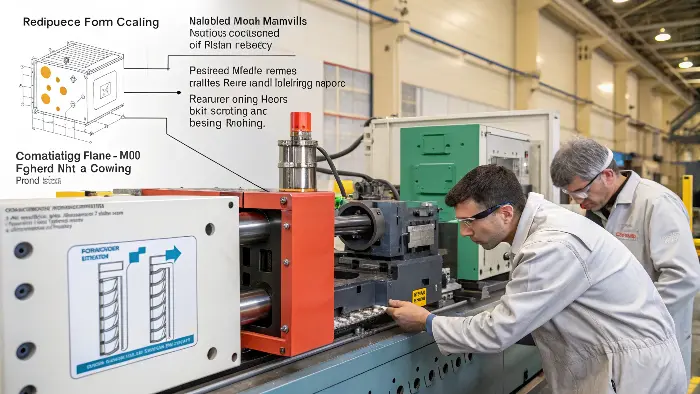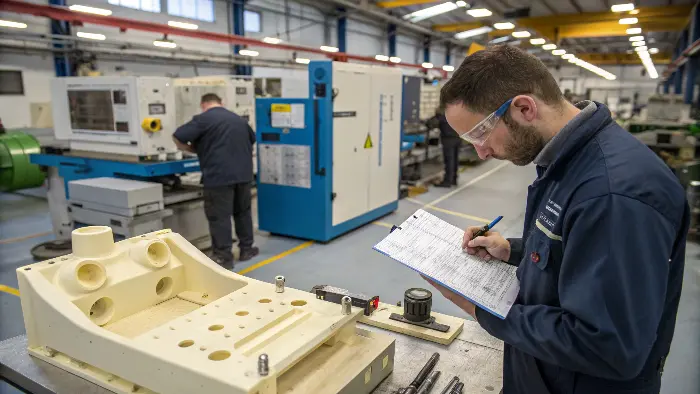Seeing your meticulously designed automotive parts come out warped is incredibly frustrating, right? It throws schedules off and inflates costs. At CKMOLD, we’ve made it our mission to tackle this.
CKMOLD resolves automotive part warpage by rigorously optimizing cooling systems, strategically redesigning molds for balanced flow and structural integrity, fine-tuning processing parameters, and selecting ideal low-shrinkage materials.
Transition Paragraph:
Warpage – it’s a persistent gremlin in the world of injection molding, especially for complex automotive components where precision is non-negotiable. I’ve walked factory floors and seen the piles of rejected parts. For business owners like Michael, who rely on consistent quality for their manufacturing operations, this isn’t just an annoyance; it’s a direct hit to the bottom line. But here’s the good news: warpage isn’t an unbeatable foe. It’s a problem that, with a systematic approach, can be understood and, more importantly, solved. So, let’s explore how we at CKMOLD break down this challenge and get those parts coming out perfectly, time after time. It really boils down to understanding the ‘why’ before you can truly master the ‘how’.
How Do You Solve Warpage Problems in General?
Facing warped parts can feel like a complex puzzle with too many pieces. You know there’s a solution, but where do you even begin to look when a part just isn’t holding its shape?
Solving warpage problems fundamentally involves a multi-pronged strategy: optimizing the cooling process for uniformity, refining the mold design for balanced fill and stress reduction, adjusting processing parameters for control, and selecting materials with inherent dimensional stability.
Dive deeper Paragraph:
When I first got into this business, warpage seemed like this mystical force. But over the years, working on countless projects, I’ve learned it’s all about physics and control. It’s not just one thing, you see. It’s usually a combination of factors conspiring against your perfect part. At CKMOLD, our first step is always a thorough diagnosis. Think of it like a doctor examining a patient. We look at the part design, the material, the mold, and the process. For automotive parts, this is especially critical because they are often large, have varying thicknesses, and demand tight tolerances.
Our general approach to tackling warpage rests on a few key pillars:
The Core Pillars for Conquering Warpage
| Pillar | Key Actions & CKMOLD Focus | Why It’s Crucial for Warpage |
|---|---|---|
| Material Science | Selecting plastics with low, predictable shrinkage (e.g., amorphous types or filled polymers). Conducting material flow analysis. | Different materials shrink differently. Inconsistent or high shrinkage is a primary warpage driver. We help choose the right armor for your part. |
| Mold Design Finesse | Ensuring uniform wall thickness, strategic gate locations, robust support (ribs/gussets), and effective venting. | The mold is the "master shaper." Flaws here directly translate to part defects. Balanced flow and stress distribution are key design goals for us. |
| Cooling Strategy | Designing cooling channels for even temperature distribution across the mold. Considering conformal cooling for complex parts. | Uneven cooling = uneven shrinkage = warpage. This is often the biggest culprit, and where we often find significant improvements. It’s a game-changer. |
| Process Precision | Optimizing injection speed, packing pressure, packing time, melt temperature, and mold temperature. | How the plastic is injected, packed, and cooled within the machine cycle dramatically impacts internal stresses and final part geometry. We fine-tune this. |
This holistic view means we don’t just tweak one setting and hope for the best. We systematically analyze and optimize each area. For a business owner like Michael, this means fewer headaches and more reliable production. It’s about building quality in, not inspecting defects out.
How Can We Reduce Warpage Specifically in Injection Molding?
Knowing the general causes is one thing, but how do we get down to the nitty-gritty within the injection molding process itself to stop warpage before it even starts? This is where the real engineering comes in.
Reducing warpage in injection molding hinges on precise control over material flow through optimized gate/runner design, achieving highly uniform mold cooling (often with conformal channels), maintaining consistent part wall thickness, and applying correct packing pressure and time.

Dive deeper Paragraph:
Alright, so let’s zoom in on the injection molding machine and the mold itself. This is where the magic—or the mischief, if things go wrong—happens. I’ve seen so many cases where a perfectly good part design gets ruined by a less-than-optimal molding setup, especially with demanding automotive components that might have long flow paths or intricate details.
At CKMOLD, when we focus on in-mold warpage reduction, our "Master Molding Right" philosophy really comes to the forefront. Here’s what we zero in on:
- Cooling Optimization – The Absolute King:
I can’t stress this enough. Uneven cooling is the arch-nemesis of flat parts. If one section of your part cools and solidifies faster than another, it’s going to shrink at a different rate, creating internal stresses that pull and twist the part.- Uniform Cooling Channels: We meticulously design cooling channels in the mold to ensure the entire part surface cools as evenly as possible. This might mean more channels, or channels placed closer to tricky areas.
- Temperature-Controlled Molds: Using precise temperature control units prevents hot spots and promotes that even shrinkage.
- Advanced Techniques: For complex automotive parts, we often recommend and design molds with conformal cooling. These are cooling channels that literally follow the contours of the part, providing incredibly uniform cooling. It’s a step up, but the reduction in warpage and cycle time can be phenomenal. I remember an automotive interior trim piece, long and thin, that was a nightmare to keep straight. Conformal cooling was the key that unlocked consistent quality for that client.
- Mold Design Improvements – The Blueprint for Stability:
- Gate and Runner Design: Where and how the molten plastic enters the mold (the gate) and how it travels there (the runners) is critical. We aim for balanced flow, so all parts of the cavity fill at roughly the same time and pressure. For larger automotive parts, we might use multiple gates or sequential valve gates to precisely control the fill pattern and prevent overpacking in some areas while underfilling others – both can lead to warpage.
- Wall Thickness Uniformity: This is a big one. If your part has a really thick section next to a thin one, the thick section will cool slower and shrink more, leading to warp. We work with designers to make wall thicknesses as uniform as possible or use features like coring or ribs to achieve strength without massive thickness variations.
- The Power of Simulation:
Before any steel is cut for the mold, we often use sophisticated software like Moldex3D. This allows us to simulate the entire injection molding process – how the plastic flows, how it cools, and critically, predict potential warpage. This way, we can make design changes virtually and optimize the mold and process parameters before committing to expensive tooling. It’s like having a crystal ball for plastics! This is invaluable for complex automotive geometries.
By focusing intensely on these in-mold factors, we proactively design warpage out of the part.How to Fix the Underlying Causes of Warped Parts in Injection Molding, and Can Already Warped Parts Be Salvaged?
So, you’ve got warped parts. The immediate question is "Can we fix these?" But the more important long-term question for someone like Michael is, "How do we stop this from happening again?" Let’s tackle both.
Fixing warped parts primarily involves rectifying the molding process (e.g., adjusting fill rates, cooling times, pressures) or mold design. For unavoidable, predictable warpage, "reverse deformation" is designed into the mold. Salvaging already warped parts is difficult and rarely ideal.

Dive deeper Paragraph:
Seeing a batch of freshly molded automotive components, perhaps a set of interior door handles or a complex engine cover, come out looking more like potato chips than precision parts is a tough moment. My first instinct, and what I always advise at CKMOLD, is to dive deep into the root cause rather than just trying to "bend them back." While sometimes, for very minor issues, a post-molding fixture used during final cooling can help a part settle into shape, it’s usually a band-aid, not a cure. True "fixing" means fixing the source.
Here’s how we approach "fixing" the propensity for warpage: - Process Parameter Adjustments – The Fine-Tuning:
This is often the first place we look for quick wins. Tiny changes can have big impacts.- Fill Rate: Injecting the plastic too fast can cause high shear and stress; too slow can lead to premature freezing and uneven packing.
- Packing Pressure & Time: This is crucial. After the mold is filled, packing pressure compensates for shrinkage as the plastic cools. Insufficient packing leads to sinks and voids (which contribute to warpage), while excessive packing can cause stress. We experiment to find that sweet spot. Sometimes, for really tough parts, advanced process optimization tools, even those leveraging concepts from AI or neural networks to analyze data and predict outcomes, are being explored in the industry to dial these in perfectly.
- Temperatures (Melt & Mold): These affect viscosity, flow, and cooling rate. We ensure they are optimal for the specific material and part geometry.
- Material Selection – Choosing Your Champion:
Sometimes, the material itself is a major contributor.- Low-Shrinkage Materials: Amorphous plastics (like ABS, Polycarbonate) generally shrink less and more uniformly than semi-crystalline ones (like Nylon, Polypropylene), making them less prone to warpage. Of course, the application dictates material choice, but if warpage is a persistent issue and options exist, this is a key consideration.
- Filled Materials: Adding fillers like glass fibers can significantly reduce shrinkage and increase stiffness, which helps resist warpage. We’ve had great success with fiber-reinforced composites for automotive parts that need to be both lightweight and dimensionally stable.
- Reverse Deformation Technique – Bending it "Right":
This is a really clever one, especially for parts where some warpage is almost unavoidable due to complex geometry or material behavior. Companies like Shape, as you mentioned, pioneer this. Essentially, we use simulation tools (like Moldex3D) to predict exactly how the part will warp. Then, we intentionally design the mold cavity to be the "opposite" of that warp. So, when the part cools and distorts, it actually warps into the correct final shape! It sounds counterintuitive, like making the mold slightly "wrong" so the part comes out "right," but it’s a highly effective strategy for high-precision components. This is particularly relevant for large automotive panels or components with asymmetric features.
Fixing the root cause is always our goal at CKMOLD. While post-molding jigs or fixtures might occasionally be used to help a part settle, we see them as a last resort. The real win is a stable, repeatable process that produces perfect parts from the get-go. That’s what keeps Michael’s production lines running smoothly.Conclusion
Ultimately, conquering warpage in complex automotive parts isn’t about a single magic bullet. It’s CKMOLD’s systematic approach, combining material science, intelligent mold design, precise process control, and sometimes even "out-of-the-box" thinking like reverse deformation.
